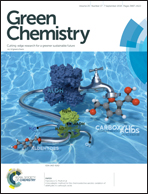Heterogenization of homogeneous chiral polymers in metal–organic frameworks with enhanced catalytic performance for asymmetric catalysis†
Abstract
Metal–organic framework (MOF)-based asymmetric heterogeneous catalysts have attracted increasing attention; however, some challenges need to be addressed, such as the rigidity of chiral auxiliary groups within MOFs and the lack of a versatile methodology for the facile construction of chiral MOFs. To address this issue, in this study, a mechanistically distinct approach was developed for heterogenizing linear chiral catalysts in the MOF cavities, rather than the synthetic modification of MOFs. This strategy involves the facile in situ polymerization of pre-impregnated chiral monomers within MOFs, affording the hybrid composites featuring a locally homogeneous and globally heterogeneous structure. The introduced chiral catalytic sites would be flexible in the pores, offering an opportunity to exploit its cooperative effect with the nearby catalytic metal nodes. The advantages of the chiral polymer/MOF composites were clarified by their excellent diastereo- and enantioselectivities and recycling capacity for catalyzing the asymmetric Aldol reaction, which were superior to those of individually heterogeneous and homogeneous catalysts.



 Please wait while we load your content...
Please wait while we load your content...